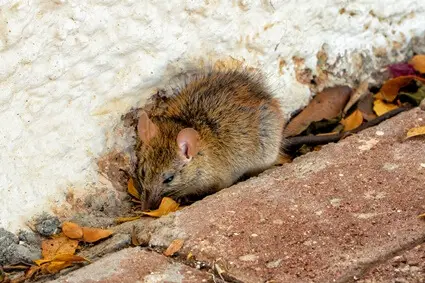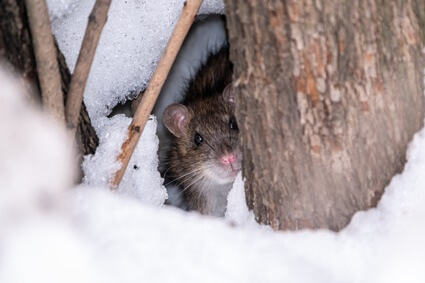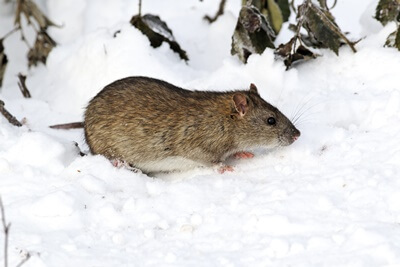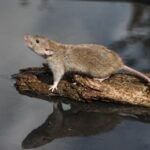Rats are hardy creatures capable of surviving in some of the most extreme environments. Despite being active all year round, people often wonder if they hibernate during the winter.
Rats don’t hibernate during the cold winter months. Instead, they shelter indoors to keep warm and to conserve their energy.
Sheltering in people’s homes allows them to take advantage of any food reserves, minimizing their need to forage for food in dangerous outdoor conditions.
While rats don’t hibernate in the winter, there are several survival strategies they employ to make it through the cold months. Understanding their behavior will enable you to keep rats out of your home.
How Do Endotherms Regulate Body Temperature?
Endotherms are organisms that regulate their body temperature by producing heat within their bodies rather than relying on ambient heat.
Examples of endotherms include humans, cats, and rodents.
According to Frontiers in Physiology, endotherms regulate their core body heat by adjusting metabolic heat production, making their body temperatures more stable than their external environment.
By contrast, ectotherms, such as lizards and snakes, cannot regulate their internal body temperature. They take on the temperature of their environment.
Endotherms have physiological responses and body structures that help stimulate metabolic heat production in response to cold temperature, including:
Blood Circulatory Mechanisms
The skin is the main point of contact for heat exchange between the body and the external environment.
So, controlling the flow of blood to the skin is a key way that organisms regulate the rate at which they gain and lose heat to their environment.
When it’s hot, endotherms such as rats shrink the diameter of blood vessels that supply blood to the skin and tail. This process is known as vasoconstriction. It reduces blood flow to the skin and tail, thus retaining their body heat.
When it’s cold, rats dilate their blood vessels to promote more blood flow to the skin and tail. This allows them to lose the excess heat to their environment, thus cooling the body.

Countercurrent Heat Exchange
Some endotherms, such as birds, have countercurrent heat exchangers. These allow heat transfer from blood vessels containing warmer blood to those with cooler blood.
To understand how this works, consider the example: The leg of the wading bird has an artery that carries warm blood from the body. This is positioned alongside a vein that carries cold blood from the foot.
As the warm blood in the artery descends the leg, it transfers much of its heat to the ascending cold blood in the vein through conduction.
This ensures that less heat is lost in the foot due to the reduced temperature difference between the cooled blood and the bird’s environment.
Insulation
Most endotherms can reduce heat transfer to the environment due to the insulation material that covers their skin.
For instance, mammals such as rats have a thick layer of fur that traps a layer of air next to their skin, minimizing heat loss to their environment.
Birds have feathers, and water mammals such as whales and dolphins have a layer of fat known as blubber, which functions similarly.
Behavioral Regulation
According to Comparative Medicine, some endotherms adopt behaviors to increase body heat and limit energy expenditure.
Rodents may huddle together in groups to keep warm when it gets cold.
Are Rats Active In Winter?
Rats are active all year round, including the winter. However, they tend to be less active as the temperatures drop to manage their energy needs.
Rodents are also more attracted to people’s homes during winter than any other time of the year. That’s because nesting indoors allows them to escape the harsh climate outdoors.
How Do Rats Survive Winter
Since rats are poorly equipped to deal with the cold weather, they tend to employ certain behaviors to survive the winter. These include:
Seeking Shelter In Human Dwellings
When the temperatures drop during winter, rats retreat into homes to escape the harsh weather outdoors.
If you live in a rat-prone area, you’re more likely to experience an infestation during winter than at any other time of the year.
Rats will hide in attics, basements, and other isolated locations during the cold season.
Stockpiling Food
During the winter season, food tends to be scarcer in the wild. As hardy and dynamic creatures, rats recognize the need to prepare for this eventuality.
This will ensure their survival throughout the winter months. So, at the beginning of autumn, rats will start foraging for more food and store some of it for future consumption.

Building Nests
Once rats secure a building to hide in during the winter months, they’ll focus on building nests. Rats’ nests are less complex and organized than birds’ nests.
Instead of weaving twigs, feathers, and leaves, rats pile pieces of shredded material such as fabric, paper, and cardboard to create their nests.
For rats, the nest’s location matters more than the nesting material. Rats prefer warm and dark places that are safe from predators and human interference.
Can Rats Survive Freezing Temperatures
While rats are highly resilient creatures capable of surviving in different climates, they don’t fare well in extremely cold weather.
If the temperatures drop below the freezing point, rats may get sick or die from hypothermia. This explains why they seek shelter inside people’s homes during the winter.
At What Temperature Do Wild Rats Die?
The optimal temperature for rats ranges between 65-80 degrees Fahrenheit.
If the temperatures rise beyond the upper limit of what is optimal, rats will start to experience discomfort, and they may be at risk of dying from heatstroke.
Likewise, if the temperature in their environment drops below 65 degrees, rats may die from hypothermia.
Do Rats Like Cold Rooms?
While it’s unclear whether rats like cold rooms, they can survive all year round, even during the winter when temperatures drop significantly.
Rats have physiological adaptations that allow them to minimize heat loss during cold weather.
For instance, their thick furs trap a layer of air next to the skin, thus enabling them to reduce the transfer of body heat to their environment.
Similarly, their blood vessels constrict when it is cold, thus reducing blood flow to the skin and tail. This makes it possible to retain much of their body heat, supporting various metabolic activities.







